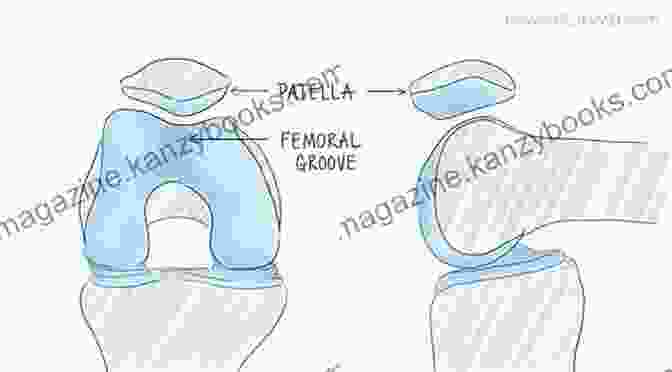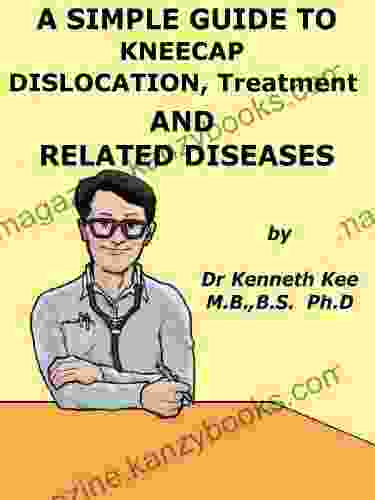Mastering Kneecap Dislocations: A Comprehensive Guide to Treatment and Related Diseases

4.6 out of 5
| Language | : | English |
| File size | : | 435 KB |
| Text-to-Speech | : | Enabled |
| Screen Reader | : | Supported |
| Enhanced typesetting | : | Enabled |
| Word Wise | : | Enabled |
| Print length | : | 102 pages |
| Lending | : | Enabled |
Kneecap dislocation, also known as patellar dislocation, is a common knee injury that occurs when the kneecap (patella) slips out of its usual position, most often to the outside of the knee. This sudden displacement can cause intense pain, swelling, and instability. Understanding the causes, treatment options, and potential complications associated with kneecap dislocations is crucial for optimal recovery and long-term knee health.
Understanding Kneecap Dislocations

The kneecap is a small, triangular bone that sits in front of the knee joint. It helps to protect the knee joint and acts as a lever for the quadriceps muscles, which extend the knee. Kneecap dislocations occur when the kneecap is forced out of place, typically due to a forceful blow or twisting motion. The most common type of kneecap dislocation is a lateral dislocation, where the kneecap moves to the outside of the knee.
Causes of Kneecap Dislocations
Kneecap dislocations can be caused by a variety of factors, including:
- Sudden impact: A direct blow to the knee or a fall onto the knee can dislocate the kneecap.
- Twisting motion: Rapid twisting or pivoting movements, especially while the knee is bent, can put stress on the kneecap and cause it to dislocate.
- Overuse: Repetitive motions, such as running or jumping, can strain the muscles and ligaments around the knee, making it more susceptible to dislocation.
- Muscle weakness: Weak quadriceps or hamstring muscles can compromise the stability of the knee, increasing the risk of dislocation.
- Anatomical abnormalities: Some people have a shallow groove on the femur (thigh bone) where the kneecap sits, which makes the kneecap more prone to dislocation.
Symptoms of Kneecap Dislocations
The symptoms of a kneecap dislocation can vary depending on the severity of the injury. Common symptoms include:
- Sudden, intense pain: The pain may be sharp and localized to the front of the knee.
- Swelling: The knee joint may swell rapidly due to bleeding and inflammation.
- Instability: The knee may feel unstable or give way when trying to bear weight.
- Deformity: The kneecap may be visibly dislocated to the side of the knee.
- Bruising: The skin around the knee may become bruised.
Treatment Options for Kneecap Dislocations
Treatment for kneecap dislocations depends on the severity of the injury and the underlying cause. The primary goal of treatment is to reduce the dislocation and restore the kneecap to its proper position. This may involve:
- Manual reduction: A healthcare professional will gently manipulate the kneecap back into place.
- Closed reduction: The healthcare professional uses a gentle force to push the kneecap back into place without making an incision.
- Open reduction: This is a surgical procedure that involves making an incision to reposition the kneecap.
After the dislocation has been reduced, treatment typically involves:
- Immobilization: The knee may be immobilized using a brace or cast to allow the soft tissues to heal.
- Physical therapy: Physical therapy exercises help to strengthen the muscles around the knee and improve joint stability.
- Medication: Pain relievers and anti-inflammatory medications may be prescribed to manage pain and swelling.
- Surgery: In some cases, surgery may be necessary to repair or reconstruct damaged ligaments or tendons.
Rehabilitation After Kneecap Dislocation
Rehabilitation after a kneecap dislocation is essential for restoring knee function and preventing future dislocations. The rehabilitation plan will vary depending on the severity of the injury but may include:
- Gradual range of motion exercises: These exercises help to increase the flexibility and motion of the knee joint.
- Strengthening exercises: These exercises help to strengthen the muscles around the knee.
- Proprioceptive exercises: These exercises help to improve balance and coordination.
- Functional activities: These activities help to transition the knee back to everyday use.
Related Diseases and Conditions
Kneecap dislocations can sometimes be associated with other diseases and conditions, including:
- Osteoarthritis: Kneecap dislocations can increase the risk of developing osteoarthritis, a degenerative joint disease.
- Cartilage damage: The cartilage that lines the knee joint can be damaged during a kneecap dislocation.
- Meniscus tear: The meniscus is a C-shaped piece of cartilage that helps to cushion the knee joint. It can be torn during a kneecap dislocation.
Kneecap dislocations are common knee injuries that can range from mild to severe. Understanding the Ursachen, symptoms, treatment options, and related diseases associated with kneecap dislocations is crucial for optimal recovery and long-term knee health. With proper treatment and rehabilitation, most people can regain full function of their knee after a kneecap dislocation.
4.6 out of 5
| Language | : | English |
| File size | : | 435 KB |
| Text-to-Speech | : | Enabled |
| Screen Reader | : | Supported |
| Enhanced typesetting | : | Enabled |
| Word Wise | : | Enabled |
| Print length | : | 102 pages |
| Lending | : | Enabled |
Do you want to contribute by writing guest posts on this blog?
Please contact us and send us a resume of previous articles that you have written.
 Book
Book Novel
Novel Page
Page Chapter
Chapter Text
Text Story
Story Genre
Genre Reader
Reader Library
Library Paperback
Paperback E-book
E-book Magazine
Magazine Newspaper
Newspaper Paragraph
Paragraph Sentence
Sentence Bookmark
Bookmark Shelf
Shelf Glossary
Glossary Bibliography
Bibliography Foreword
Foreword Preface
Preface Synopsis
Synopsis Annotation
Annotation Footnote
Footnote Manuscript
Manuscript Scroll
Scroll Codex
Codex Tome
Tome Bestseller
Bestseller Classics
Classics Library card
Library card Narrative
Narrative Biography
Biography Autobiography
Autobiography Memoir
Memoir Reference
Reference Encyclopedia
Encyclopedia Rose Lamatt
Rose Lamatt Ken Gullette
Ken Gullette Russell Reich
Russell Reich Lauren Baker
Lauren Baker Samuel Tristan Ludlow
Samuel Tristan Ludlow M A Kabir
M A Kabir Lynn Eib
Lynn Eib Ken Wilson
Ken Wilson Luca Zavarella
Luca Zavarella Keith Miller
Keith Miller Khadiyah Preciado
Khadiyah Preciado Selva Sugunendran
Selva Sugunendran Keith Elliot Greenberg
Keith Elliot Greenberg Ken Lloyd
Ken Lloyd Tasche Laine
Tasche Laine Kevin Sands
Kevin Sands Mandy Aftel
Mandy Aftel Rich Gibson
Rich Gibson Laura Romano
Laura Romano Monica Harris
Monica Harris
Light bulbAdvertise smarter! Our strategic ad space ensures maximum exposure. Reserve your spot today!

 Clarence MitchellHoney Soy Broiled Salmon: 19 Other Great Tasting Heart Healthy Recipes...
Clarence MitchellHoney Soy Broiled Salmon: 19 Other Great Tasting Heart Healthy Recipes...
 Patrick RothfussThe Ultimate Cookbook: Unlocking the Secrets to Culinary Excellence at Home
Patrick RothfussThe Ultimate Cookbook: Unlocking the Secrets to Culinary Excellence at Home Fyodor DostoevskyFollow ·3.7k
Fyodor DostoevskyFollow ·3.7k Clay PowellFollow ·16.9k
Clay PowellFollow ·16.9k Lee SimmonsFollow ·19.6k
Lee SimmonsFollow ·19.6k David BaldacciFollow ·19.4k
David BaldacciFollow ·19.4k E.M. ForsterFollow ·12.3k
E.M. ForsterFollow ·12.3k Ethan MitchellFollow ·17.4k
Ethan MitchellFollow ·17.4k Yasunari KawabataFollow ·11.2k
Yasunari KawabataFollow ·11.2k Ralph TurnerFollow ·16.3k
Ralph TurnerFollow ·16.3k

 Ernesto Sabato
Ernesto SabatoLoving Table: Creating Memorable Gatherings
Gatherings...

 Mark Twain
Mark TwainLifestyle After Cancer: The Facts
Cancer is a life-changing...

 Keith Cox
Keith CoxUnlocking the Nutritional Needs of Individuals with...
Individuals with physical disabilities...

 Rubén Darío
Rubén DaríoHandbook And Guide To Evaluation And Treatment
Empowering Healthcare...

 Andy Hayes
Andy HayesUnveiling the Truth: "Garden Myths" by Robert Pavlis...
The world of gardening is often filled with a...
4.6 out of 5
| Language | : | English |
| File size | : | 435 KB |
| Text-to-Speech | : | Enabled |
| Screen Reader | : | Supported |
| Enhanced typesetting | : | Enabled |
| Word Wise | : | Enabled |
| Print length | : | 102 pages |
| Lending | : | Enabled |










